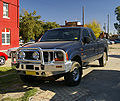2004 Ford F250 Diesel Supplement 2nd Printing - Page 13
2004 Ford F250 Manual
Page 13 highlights
Driving 2. When the glow plug pre-heat indicator turns off, turn the key to 5 (START), then release the key as soon as the engine starts. The glow plugs will continue to be activated for two minutes after the glow plug pre-heat indicator has turned off. If the engine is not started before the glow plug activation time ends, the glow plugs will need to be reset by turning the key to 3 (OFF). 3. After the engine starts, allow it to idle for about 15 seconds. Do not increase engine speed until the oil pressure gauge indicates normal pressure. STOPPING THE ENGINE Turn the ignition to 3 (OFF). To prolong engine life (after extended high speed or maximum GVW operation), it is recommended that a hot engine be allowed to operate at low idle for about 7-10 minutes which would allow sufficient time for the turbocharged engine to cool down. COLD WEATHER OPERATION Changing to a lighter grade engine oil also makes starting easier under these conditions. Refer to Engine oil specifications in the Maintenance and Specifications section of this supplement. At temperatures below -7°C (20°F), Number 2-D diesel fuel may thicken enough to clog the fuel filter. Your vehicle is equipped with either an FCM (E-Series) or an HFCM (F-Super Duty and Excursion) which acts as a fuel filter/heater/water separator to keep the wax melted which will help prevent fuel filter clogging. However, if the engine starts but stalls after a short time and will not restart, the fuel filter(s) may be clogged. For best results in cold weather, use Number 1-D diesel fuel or "winterized" Number 2-D diesel fuel which has an additive to minimize wax formation. Your vehicle is also equipped with a bypass relief valve, located on the fuel control module, which provides fuel flow to the engine if the fuel pickup should become plugged by ice or wax. To allow this bypass valve to function and avoid engine fuel starvation, it is recommended that, during cold weather operation 0°C (32°F) or below, the fuel level in your tank should not be allowed to drop below 1⁄4 full. This will help prevent air from entering the fuel system and stalling the engine. In cold weather below 0°C (32°F) your diesel engine will slowly increase to a higher idle speed if left idling in P (Park). As the engine warms-up, the engine sound level will decrease due to the activation of PCM-controlled sound reduction features. 13
















